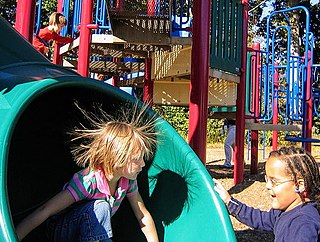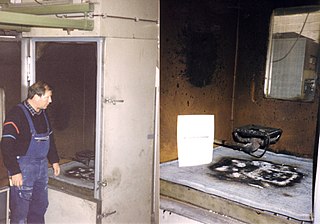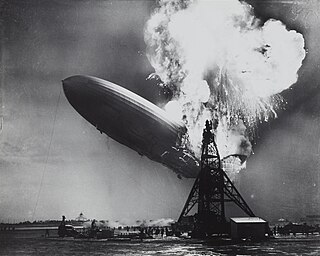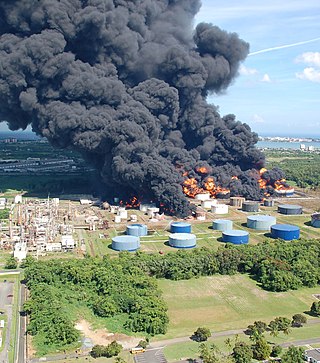
Ammonium nitrate is a chemical compound with the formula NH4NO3. It is a white crystalline salt consisting of ions of ammonium and nitrate. It is highly soluble in water and hygroscopic as a solid, although it does not form hydrates. It is predominantly used in agriculture as a high-nitrogen fertilizer.

Static electricity is an imbalance of electric charges within or on the surface of a material. The charge remains until it can move away by an electric current or electrical discharge. The word "static" is used to differentiate it from current electricity, where an electric charge flows through an electrical conductor.
Coal dust is a fine-powdered form of coal which is created by the crushing, grinding, or pulverization of coal rock. Because of the brittle nature of coal, coal dust can be created by mining, transporting, or mechanically handling it.
A chemical accident is the unintentional release of one or more hazardous chemicals, which could harm human health and the environment. Such events include fires, explosions, and release of toxic materials that may cause people illness, injury, or disability. Chemical accidents can be caused for example by natural disasters, human error, or deliberate acts for personal gain. Chemical accidents are generally understood to be industrial-scale ones, often with important offsite consequences. Unintended exposure to chemicals that occur at smaller work sites, as well as in private premises during everyday activities are usually not referred to as chemical accidents.

The Texas City refinery explosion occurred on March 23, 2005, when a flammable hydrocarbon vapor cloud ignited and violently exploded at the isomerization process unit of the BP oil refinery in Texas City, Texas, killing 15 workers, injuring 180 others and severely damaging the refinery. All the fatalities were contractors working out of temporary buildings located close to the unit to support turnaround activities. Property loss was $200 million. When including costs of repairs, deferred production, fines and settlements, the explosion is the world's costliest refinery accident.

In electrical and safety engineering, hazardous locations are places where fire or explosion hazards may exist. Sources of such hazards include gases, vapors, dust, fibers, and flyings, which are combustible or flammable. Electrical equipment installed in such locations can provide an ignition source, due to electrical arcing, or high temperatures. Standards and regulations exist to identify such locations, classify the hazards, and design equipment for safe use in such locations.
Mixtures of dispersed combustible materials and oxygen in the air will burn only if the fuel concentration lies within well-defined lower and upper bounds determined experimentally, referred to as flammability limits or explosive limits. Combustion can range in violence from deflagration through detonation.

The U.S. Chemical Safety and Hazard Investigation Board (USCSB), generally referred to as the Chemical Safety Board (CSB), is an independent U.S. federal agency charged with investigating industrial chemical accidents. Headquartered in Washington, D.C., the agency's board members are appointed by the president and confirmed by the United States Senate. The CSB conducts root cause investigations of chemical accidents at fixed industrial facilities.

A combustible material is a material that can burn in air under certain conditions. A material is flammable if it ignites easily at ambient temperatures. In other words, a combustible material ignites with some effort and a flammable material catches fire immediately on exposure to flame.

A dust explosion is the rapid combustion of fine particles suspended in the air within an enclosed location. Dust explosions can occur where any dispersed powdered combustible material is present in high-enough concentrations in the atmosphere or other oxidizing gaseous medium, such as pure oxygen. In cases when fuel plays the role of a combustible material, the explosion is known as a fuel-air explosion.
On 23 October, 1989 at approximately 1:05 PM Central Daylight Time, a series of explosions occurred at Phillips Petroleum Company's Houston Chemical Complex in Pasadena, Texas, near the Houston Ship Channel. The initial blast registered 3.5 on the Richter scale, and the resulting fires took 10 hours to bring under control, as efforts to battle the fire were hindered due to damaged water pipes for the fire hydrants from the blast. The initial explosion was found to have resulted from a release of extremely flammable process gasses used to produce high-density polyethylene, a plastic used for various consumer food container products. The US Occupational Safety and Health Administration fined Phillips Petroleum Company $5,666,200 and fined Fish Engineering and Construction, inc, the maintenance contractor, $729,600. The event killed 23 employees and injured 314.

On 7 February 2008, fourteen people were killed and thirty six injured during a dust explosion at a refinery owned by Imperial Sugar in Port Wentworth, Georgia, United States. Dust explosions had been an issue of concern among U.S. authorities since three fatal accidents in 2003, with efforts made to improve safety and reduce the risk of reoccurrence.

Hydrogen safety covers the safe production, handling and use of hydrogen, particularly hydrogen gas fuel and liquid hydrogen. Hydrogen possesses the NFPA 704's highest rating of four on the flammability scale because it is flammable when mixed even in small amounts with ordinary air. Ignition can occur at a volumetric ratio of hydrogen to air as low as 4% due to the oxygen in the air and the simplicity and chemical properties of the reaction. However, hydrogen has no rating for innate hazard for reactivity or toxicity. The storage and use of hydrogen poses unique challenges due to its ease of leaking as a gaseous fuel, low-energy ignition, wide range of combustible fuel-air mixtures, buoyancy, and its ability to embrittle metals that must be accounted for to ensure safe operation.

West Pharmaceutical Services, Inc. is a designer and manufacturer of injectable pharmaceutical packaging and delivery systems. Founded in 1923 by Herman O. West and J.R. Wike of Philadelphia, the company is headquartered in Exton, Pennsylvania. In its early years of development, West produced rubber components for packaging injectable drugs, providing a sterile environment for the producers of penicillin and insulin.

The 2009 Cataño oil refinery fire, also known as the CAPECO explosion, was a fire that began with an explosion on October 23, 2009, and was extinguished on October 25 at the Caribbean Petroleum Corporation (CAPECO) oil refinery and oil depot in Bayamón, Puerto Rico. While the fire and subsequent explosion occurred close to the city of Cataño, it technically occurred within the borders of Bayamón, even though Cataño was more affected by fumes and evacuation. There were no fatalities, but 3 people were injured.

An industrial fire is a type of industrial disaster involving a conflagration which occurs in an industrial setting. Industrial fires often, but not always, occur together with explosions. They are most likely to occur in facilities where there is a lot of flammable material present. Such material can include petroleum, petroleum products such as petrochemicals, or natural gas. Processing flammable materials such as hydrocarbons in units at high temperature and/or high pressure makes the hazards more severe. Facilities with such combustible material include oil refineries, tank farms, natural gas processing plants, and chemical plants, particularly petrochemical plants. Such facilities often have their own fire departments for firefighting. Sometimes dust or powder are vulnerable to combustion and their ignition can cause dust explosions. Severe industrial fires have involved multiple injuries, loss of life, costly financial loss, and/or damage to the surrounding community or environment.

On April 17, 2013, an ammonium nitrate explosion occurred at the West Fertilizer Company storage and distribution facility in West, Texas, United States, while emergency services personnel were responding to a fire at the facility. Fifteen people were killed, more than 160 were injured, and more than 150 buildings were damaged or destroyed. Investigators confirmed that ammonium nitrate was the material that exploded. On May 11, 2016, the Bureau of Alcohol, Tobacco, Firearms and Explosives stated that the fire had been deliberately set. That finding has been disputed.

The 2010 Tesoro Anacortes Refinery disaster was an industrial accident that occurred at the Tesoro Anacortes Refinery in Anacortes, Washington on April 2, 2010. Seven workers received fatal burns in an explosion and ensuing fire when a heat exchanger violently ruptured after a maintenance restart.

In fire classes, a Class B fire is a fire in flammable liquids or flammable gases, petroleum greases, tars, oils, oil-based paints, solvents, lacquers, or alcohols. For example, propane, natural gas, gasoline and kerosene fires are types of Class B fires. The use of lighter fluid on a charcoal grill, for example, creates a Class B fire. Some plastics are also Class B fire materials.
In fire and explosion prevention engineering, purging refers to the introduction of an inert purge gas into a closed system to prevent the formation of an ignitable atmosphere. Purging relies on the principle that a combustible gas is able to undergo combustion (explode) only if mixed with air in the right proportions. The flammability limits of the gas define those proportions, i.e. the ignitable range.















